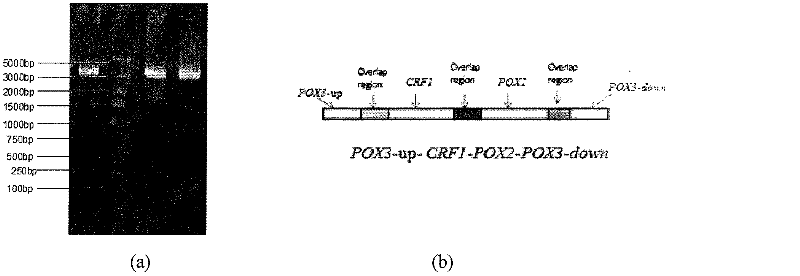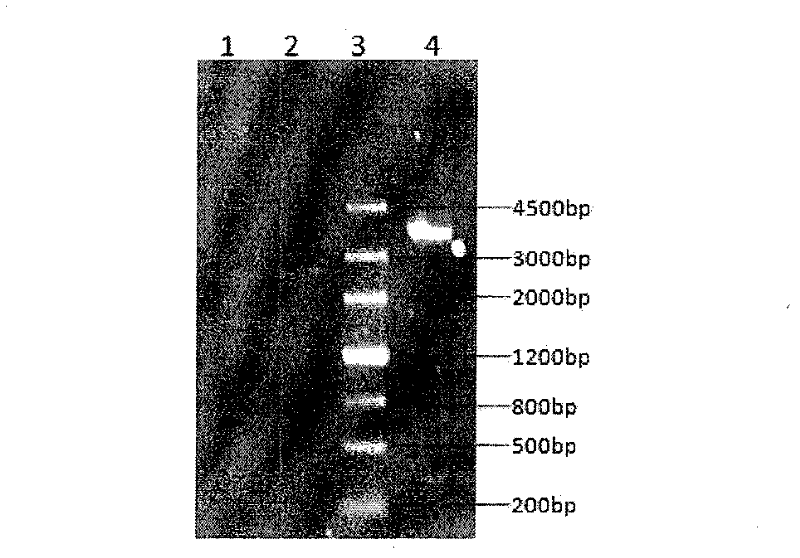Yarrowia lipolytica genetic engineering strain with high production of gamma-decalactone, as well as preparation method and application thereof
A technology of genetically engineered bacteria and genetically engineered strains, applied in the field of Yarrowia lipolytica genetically engineered bacteria
- Summary
- Abstract
- Description
- Claims
- Application Information
AI Technical Summary
Problems solved by technology
Method used
Image
Examples
Embodiment 1
[0016] Example 1. Construction of PCPP Knockout Module
[0017] 1. Extraction of total genomic DNA from wild-type Yarrowia lipolytica.
[0018] 2. Using SOE PCR technology to construct the PCPP knockout module.
[0019]The entire gene sequence of POX3 gene, CRF1 copper resistance gene and POX2 gene of Yarrowia lipolytica yeast was found out by NCBI's Entrez retrieval system, and according to the position of the CDS region and the sequence of the promoter and terminator, Primer premier 5.0 software was used Design its upstream primers and downstream primers.
[0020] Homologous sequence primers for the upper segment of the POX3 gene:
[0021] Upstream primer POX3-up-1: acaacaccttcacagagccacc
[0022] Downstream primer POX3-up-2: gaagacgagttgagacgaagactttcgcacccagttagtcgt
[0023] CRF1 gene primers:
[0024] Upstream primer CRF1-1: acgactactgggtgcgaaagtcttcgtctcaactcgtcttc
[0025] Downstream primers CRF1-2: agagccgagggagaataaacggcgaaattggcggttggtat
[0026] POX2 gene pri...
Embodiment 2
[0059] Example 2. Screening of PCPP transformants
[0060] 1. Screening of transformants
[0061] Due to the insertion of the CRF1 gene, the transformant can grow on a plate containing a higher concentration of copper ions, so that the transformant can be screened. The wild-type strain and the transformed strain were respectively cultured on plates with copper ion concentrations of 2mM, 4mM, 8mM, 10mM, 12mM, 14mM, and 16mM concentration gradients. When the concentration of copper ions in the medium reached 8mM, the growth ability of the wild-type strain was weakened, and the number of colonies decreased, but the number of colonies on the plate of the transformed strain did not change. When the copper ion concentration reaches above 12mM, the wild-type strain does not grow, but there are still colonies growing on the plate of the transformed strain.
[0062] 2. Molecular biological identification of possible transformants
[0063] Inoculate the single colony Tp-1----Tp-20 gr...
Embodiment 3
[0064] Growth ability and biotransformation ability determination of embodiment 3 transformants
[0065] 1. The growth ability of the transformant Tp-12 and the wild-type strain was tested.
[0066] The seeds of the transformant Tp-12 strain and the wild-type strain were inoculated into YEPD growth medium and castor oil medium respectively, and the composition of the castor oil medium was: 1% to 10% of castor oil, 0.1% to 1% of yeast powder, Peptone 0.1%~1%, MgSO 4 ·7H 2 O0.1%~1%, Na 2 HPO 4 0.1%~1%, KH 2 PO 4 0.01%~0.05%, Tween 80 0.1%~1%, pH 6.5-7.5. The culture conditions are: liquid volume 50mL / 250mL, shaker speed 180r / min, temperature 28°C. Samples were taken every 4 hours, the absorption wavelength at 600nm was measured by a visible light-spectrophotometer, and the relationship curve between absorbance and incubation time was drawn.
[0067] The growth curves of transformants Tp-12 and wild-type strains in YEPD and castor oil medium are as follows: image 3 As...
PUM
 Login to View More
Login to View More Abstract
Description
Claims
Application Information
 Login to View More
Login to View More - R&D
- Intellectual Property
- Life Sciences
- Materials
- Tech Scout
- Unparalleled Data Quality
- Higher Quality Content
- 60% Fewer Hallucinations
Browse by: Latest US Patents, China's latest patents, Technical Efficacy Thesaurus, Application Domain, Technology Topic, Popular Technical Reports.
© 2025 PatSnap. All rights reserved.Legal|Privacy policy|Modern Slavery Act Transparency Statement|Sitemap|About US| Contact US: help@patsnap.com



